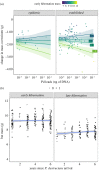Shifting effects of host physiological condition following pathogen establishment
- PMID: 36855852
- PMCID: PMC9975657
- DOI: 10.1098/rsbl.2022.0574
Shifting effects of host physiological condition following pathogen establishment
Abstract
Understanding host persistence with emerging pathogens is essential for conserving populations. Hosts may initially survive pathogen invasions through pre-adaptive mechanisms. However, whether pre-adaptive traits are directionally selected to increase in frequency depends on the heritability and environmental dependence of the trait and the costs of trait maintenance. Body condition is likely an important pre-adaptive mechanism aiding in host survival, although can be seasonally variable in wildlife hosts. We used data collected over 7 years on bat body mass, infection and survival to determine the role of host body condition during the invasion and establishment of the emerging disease, white-nose syndrome. We found that when the pathogen first invaded, bats with higher body mass were more likely to survive, but this effect dissipated following the initial epizootic. We also found that heavier bats lost more weight overwinter, but fat loss depended on infection severity. Lastly, we found mixed support that bat mass increased in the population after pathogen arrival; high annual plasticity in individual bat masses may have reduced the potential for directional selection. Overall, our results suggest that some factors that contribute to host survival during pathogen invasion may diminish over time and are potentially replaced by other host adaptations.
Keywords: Pseudogymnoascus destructans; body mass; emerging infectious disease; population impacts; white-nose syndrome; wildlife disease.
Figures


Similar articles
-
Mobility and infectiousness in the spatial spread of an emerging fungal pathogen.J Anim Ecol. 2021 May;90(5):1134-1141. doi: 10.1111/1365-2656.13439. Epub 2021 Feb 28. J Anim Ecol. 2021. PMID: 33550607 Free PMC article.
-
Pathogen dynamics during invasion and establishment of white-nose syndrome explain mechanisms of host persistence.Ecology. 2017 Mar;98(3):624-631. doi: 10.1002/ecy.1706. Ecology. 2017. PMID: 27992970
-
Laboratory Maintenance and Culture of Pseudogymnoascus destructans, the Fungus That Causes Bat White-Nose Syndrome.Curr Protoc. 2021 Jan;1(1):e23. doi: 10.1002/cpz1.23. Curr Protoc. 2021. PMID: 33497534
-
Ecology and impacts of white-nose syndrome on bats.Nat Rev Microbiol. 2021 Mar;19(3):196-210. doi: 10.1038/s41579-020-00493-5. Epub 2021 Jan 18. Nat Rev Microbiol. 2021. PMID: 33462478 Review.
-
Parallels in amphibian and bat declines from pathogenic fungi.Emerg Infect Dis. 2013 Mar;19(3):379-85. doi: 10.3201/eid1093.120707. Emerg Infect Dis. 2013. PMID: 23622255 Free PMC article. Review.
References
-
- Aguirre AA, Tabor GM. 2008. Global factors driving emerging infectious diseases impact on wildlife populations. In Animal biodiversity and emerging diseases: prediction and prevention (eds Sparagano OAE, Maillard JC, Figueroa JV), pp. 1-3. Oxford, UK: Blackwell Publishing.
-
- Smith KF, Acevedo-Whitehouse K, Pedersen AB. 2009. The role of infectious diseases in biological conservation. Anim. Conserv. 12, 1-12. (10.1111/j.1469-1795.2008.00228.x) - DOI
Publication types
MeSH terms
Associated data
LinkOut - more resources
Full Text Sources

